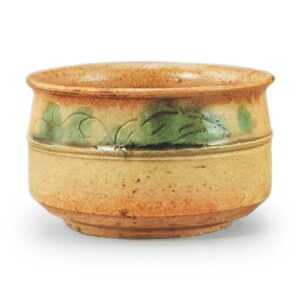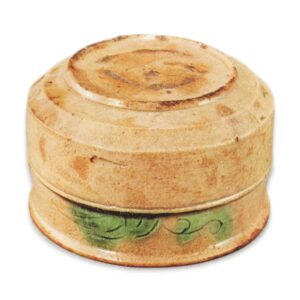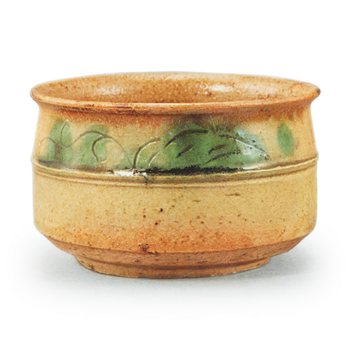

Height: 7.2cm
Diameter: 11.7cm
Height of foot: 8.0cm
Height of rim: 0.3cm
Since ancient times, Namba has been regarded as the best of the yellow Seto tea bowls, and the smoothness of its surface and the beauty of its bold design are exactly what yellow Seto tea bowls should be like. The name Namba was probably given to this area because of its high reputation at the time.
While most yellow Seto tea bowls have a flat base, Namba tea bowls have a foot ring, and this is what makes them unique. The most important thing to note about them is the glaze, which is the most important feature of yellow Seto. It is soft and moist, like a rice cake. Among the many famous pieces of Kise-do, only a few, such as the iris-patterned kettle, can be compared to this.
Furthermore, the subtle coloring of the gallstone, which is decorated with the light, delicate arabesque carving of the yellow Seto ware seen in the upper part of the bowl, is neither too dark nor too light, and has a slightly peacock-green tinge that is clear and bright. The high level of refinement and elegance of this bowl is truly reminiscent of the beauty of the Taikaku ware, and the way in which it subtly reflects the yellow Seto ware is truly a highlight of the famous Namba bowl.
The shape may seem monotonous, but it is actually very carefully designed, with a slightly constricted, strongly curved rim and a thin, sharply beveled band of decoration running around the middle of the short body. In particular, the central body strap is thickly piled up in a single line with the flow of the Iwai river, and the impression is even stronger and more vivid. In the wonder of the Iwai change, or like the grass sprouting in early spring, or like a deep green pool in a secluded valley, what is captivating and never ends is the Namba of Kiseido.
The yellow Seto tea bowl with a design of irises was originally made to be used as a side dish, and the fact that it often has a base that is wider at the bottom than at the top is probably because of this, but even though it has a foot ring, it seems that it was originally made to be used as a side dish, judging from its style of making, and the fact that it has a neat ring foot ring and the foot ring has been neatly trimmed on the side also tells us this.
The inside of the foot ring is beautifully charred, and the traces of the clay used to make the ring-shaped Koshi-no and Kise-do wares are also one of the highlights of this piece that should not be overlooked. The uneven glaze and charring from the waist to the hem also add to the beauty of the piece. There are three eyes on the inside of the piece.
Perhaps because it was made by a potter who specialized in this type of ware, the overall shape is thin and elegant, and the crisp, rhythmic beauty of the piece is in perfect harmony with the bright yellow Seto glaze and the vivid colors of the Iwai stones.
Inner box: paulownia wood, plain finish, calligraphy “Namba Seto teacup” by Kobori school, but the number of generations is unknown.
Transmitted. Formerly in the collection of Masuda Don’o, and after the war it returned to the current owner.



